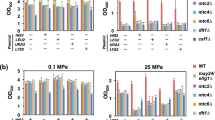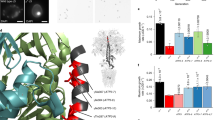Abstract
We have isolated a new class of respiration-defective, i.e petite, mutants of the yeast Saccharomyces cerevisiae. Mutations in the GEF1 gene cause cells to grow slowly on rich media containing carbon sources utilized by respiration. This phenotype is suppressed by adding high concentrations of iron to the growth medium. Gef1 − mutants also fail to grow on a fermentable carbon source, glucose, when iron is reduced to low concentrations in the medium, suggesting that the GEF1 gene is required for efficient metabolism of iron during growth on fermentable as well as respired carbon sources. However, activity of the iron uptake system appears to be unaffected in gef1 − mutants. Fe(II) transporter activity and regulation is normal in gef1 − mutants. Fe(III) reductase induction during iron-limited growth is disrupted, but this appears to be a secondary effect of growth rate alterations. The wild-type GEF1 gene was cloned and sequenced; it encodes a protein of 779 amino acids, 13 possible transmembrane domains, and significant similarity to chloride channel proteins from fish and mammals, suggesting that GEF1 encodes an integral membrane protein. A gef1 − deletion mutation generated in vitro and introduced into wild-type haploid strains by gene transplacement was not lethal. Oxygen consumption by intact gef1 − cells and by mitochondrial fractions isolated from gef1 − mutants was reduced 25–50% relative to wild type, indicating that mitochondrial function is defective in these mutants. We suggest that GEF1 encodes a transport protein that is involved in intracellular iron metabolism.
Similar content being viewed by others
References
Bradford MM (1976) A rapid and sensitive method for the quantitation of microgram quantities of protein utilizing the principle of protein-dye binding. Anal Biochem 72:248–254
Burkholder AC, Hartwell LH (1985) The yeast alpha-factor receptor: Structural properties deduced from the sequence of the STE2 gene. Nucleic Acids Res 13:8463–8475
Carle GF, Olson MV (1985) An electrophoretic karyotype for yeast. Proc Natl Acad Sci USA 82:3756–3760
Carlson M, Botstein D (1982) Two differentially regulated mRNAs with different 5′ ends encode secreted and intracellular forms of yeast invertase. Cell 28:145–154
Celenza JL, Marshall-Carlson L, Carlson M (1988) The yeast SNF3 gene encodes a glucose transporter homologous to the mammalian protein. Proc Natl Acad Sci USA 85:2130–2134
Chappell JB (1964) The oxidation of citrate, isocitrate, and cis-aconitate by isolated mitochondria. Biochem J 90:225–237
Dancis A, Klausner RD, Hinnebusch AG, Barriocanal JG (1990) Genetic evidence that ferric reductase is required for iron uptake in Saccharomyces cerevisiae. Mol Cell Biol 10:2294–2301
Dancis A, Roman DG, Anderson GJ, Hinnebusch AG, Klausner RD (1992) Ferric reductase of Saccharomyces cerevisiae: Molecular characterization, role in iron uptake, and transcriptional control by iron. Proc Natl Acad Sci USA 89:3869–3873
Dayhoff MO, Schwartz RM, Orcutt BC (1978) Atlas of Protein Sequence and Structure. National Biomedical Research Foundation, Silver Spring, Md., pp. 345–352
Devereux J, Haeberli P, Smithies O (1984) A comprehensive set of sequence analysis programs for the VAX. Nucleic Acids Res 12:387–395
Eide D, Guarente L (1992) Increased dosage of a transcriptional activator gene enhances iron-limited growth of Saccharomyces cerevisiae. J Gen Microbiol 138:347–354
Eide D, Davis-Kaplan S, Jordan I, Sipe D, Kaplan J (1992) Regulation of iron uptake in Saccharomyces cerevisiae: the ferrireductase and Fe(II) transporter are regulated independently. J Biol Chem 267:20774–20781
Forsburg SL, Guarente L (1988) Mutational analysis of upstream activation sequence 2 of the CYC1 gene of Saccharomyces cerevisiae: a HAP2-HAP3- responsive site. Mol Cell Biol 8:647–654
Hagen DC, McCaffrey G, Sprague GF (1986) Evidence the yeast STE3 gene encodes a receptor for the peptide pheromone a-factor: Gene sequence and implications for the structure of the presumed receptor. Proc Natl Acad Sci USA 83:1418–1422
Henikoff S (1984) Unidirectional digestion with exonuclease III creates targeted breakpoints for DNA sequencing. Gene 28:351–359
Hill JE, Myers AM, Koerner, TJ, Tzagoloff A (1986) Yeast/E. coli shuttle vectors with multiple unique restriction sites. Yeast 2:163–167
Hill RL, Bradshaw RA (1969) Fumarase. Methods Enzymol 13:91–99
Hirata R, Ohsumi Y, Nakano A, Kawasaki H, Suzuki K, Anraku Y (1990) Molecular structure of a gene, VMA1, encoding the catalytic subunit of H+-translocating adenosine triphosphatase from vacuolar membranes of Saccharomyces cerevisiae. J Biol Chem 265:6726–6733
Hoffman W (1985) Molecular characterization of the CAN1 locus in Saccharomyces cerevisiae: a transmembrane protein without N-terminal hydrophobic signal sequence. J Biol Chem 260:11831–11837
Huisman O, Raymond W, Froehlich K-U, Errada P, Kleckner N, Botstein D, Hoyt MA (1987) A Tn10-1acZ-kanR-URA3 gene fusion transposon for insertion mutagenesis and fusion analysis of yeast and bacterial genes. Genetics 116:191–199
Jentsch TJ, Steinmeyer K, Schwarz G (1990) Primary structure of Torpedo marmorata chloride channel isolated by expression cloning in Xenopus oocytes. Nature 348:510–514
Jund R, Weber E, Chevallier M-R (1988) Primary structure of the uracil transport protein of Saccharomyces cerevisiae. Eur J Biochem 171:417–424
Kyte J, Doolittle RF (1982) A simple method for displaying the hydropathic character of a protein. J Mol Biol 157:105–132
Lagunas R (1986) Misconceptions about the energy metabolism of Saccharomyces cerevisiae. Yeast 2:221–228
Lesuisse E, Horion B, Labbe P, Hilger F (1991) The plasma membrane ferrireductase activity of Saccharomyces cerevisiae is partially controlled by cyclic AMP. Biochem J 280:545–548
Lowry CV, Cerdan ME, Zitomer RS (1990) A hypoxic consensus operator and a constitutive activation region regulate the ANB1 gene of Saccharomyces cerevisiae. Mol Cell Biol 10:5921–5926
Marck C (1988) “DNA Strider”: a “C” program for the fast analysis of DNA and protein sequences on the Apple Macintosh family of computers. Nucleic Acids Res 16:1829–1836
Mortimer RK, Schild D (1981) Genetic mapping in Saccharomyces cerevisiae. In: Strathern J, Jones E, Broach JR (eds) The Molecular Biology of the Yeast Saccharomyces: Life Cycle and Inheritance. Cold Spring Harbor Laboratory Press, Cold Spring Harbor, New York, pp 11–26
Nakayama N, Miyajima A, Arai K (1985) Nucleotide sequences of STE2 and STE3, cell type-specific sterile genes from Saceharomyces cerevisiae. EMBO J 4:2643–2648
Nelson H, Nelson N (1989) The progenitor of ATP synthases was closely related to the current vacuolar H+-ATPase. FEBS Lett 247:147–153
Pearson WR, Lipman DJ (1988) Improved tools for biological sequence comparison. Proc Natl Acad Sci USA 85:2444–2448
Raguzzi F, Lesuisse E, Crichton RR (1988) Iron storage in Saccharomyces cerevisiae. FEBS Lett 231:253–258
Rothstein R (1991) Targeting, disruption, replacement, and allele rescue: integrative DNA transformation in yeast. Methods Enzymol 194:281–301
Sambrook J, Fritsch EF, Maniatis T (1989) Molecular cloning: A laboratory manual, 2nd edn. Cold Spring Harbor Laboratory Press, Cold Spring Harbor, New York
Sanger F, Nicklen S, Coulson AR (1977) DNA sequencing with chain-terminating inhibitors. Proc Natl Acad Sci USA 74:5463–5467
Sherman F, Fink GR, Hicks JB (1986) Methods in Yeast Genetics, Cold Spring Harbor Laboratory Press, Cold Spring Harbor, New York
Shih C-K, Wagner R, Feinstein S, Kanik-Ennulat C, Neff N (1988) A dominant trifluoperazine resistance gene from Saccharomyces cerevisiae has homology with F0F1 ATP synthase and confers calcium-sensitive growth. Mol Cell Biol 8:3094–3103
Tamanoi F (1988) Yeast RAS genes. Biochim Biophys Acta 948:1–15
Tanaka J-I, Fink GR (1985) The histidine permease gene (HIP1) of Saccharomyces cerevisiae. Gene 38:205–214
Thiemann A, Grunder S, Pusch M, Jentsch TJ (1992) A chloride channel widely expressed in epithelial and nonepithelial cells. Nature 356:57–60
Tzagoloff A, Dieckmann CL (1990) PET genes of Saccharomyces cerevisiae. Microbiol Rev 54:211–225
Umemoto N, Yoshihisa T, Hirata R, Anraku Y (1990) Roles of the VMA3 gene product, subunit c of the vacuolar membrane H+-ATPase on vacuolar acidification and protein transport. J Biol Chem 265:18447–18453
Wada Y, Ohsumi Y, Anraku Y (1992) Chloride transport of yeast vacuolar membrane vesicles: a study of in vitro vacuolar acidification. Biochim Biophys Acta 1101:296–302
Wickerham LJ (1946) A critical evaluation of the nitrogen assimilation tests commonly used in the classification of yeasts. J Bacteriol 52:293–301
Yaffe MP (1991) Analysis of mitochondrial function and assembly. Methods Enzymol 194:627–643
Author information
Authors and Affiliations
Additional information
Communicated by W. Gajewski
Rights and permissions
About this article
Cite this article
Greene, J.R., Brown, N.H., DiDomenico, B.J. et al. The GEF1 gene of Saccharomyces cerevisiae encodes an integral membrane protein; mutations in which have effects on respiration and iron-limited growth. Molec. Gen. Genet. 241, 542–553 (1993). https://doi.org/10.1007/BF00279896
Received:
Accepted:
Issue Date:
DOI: https://doi.org/10.1007/BF00279896




